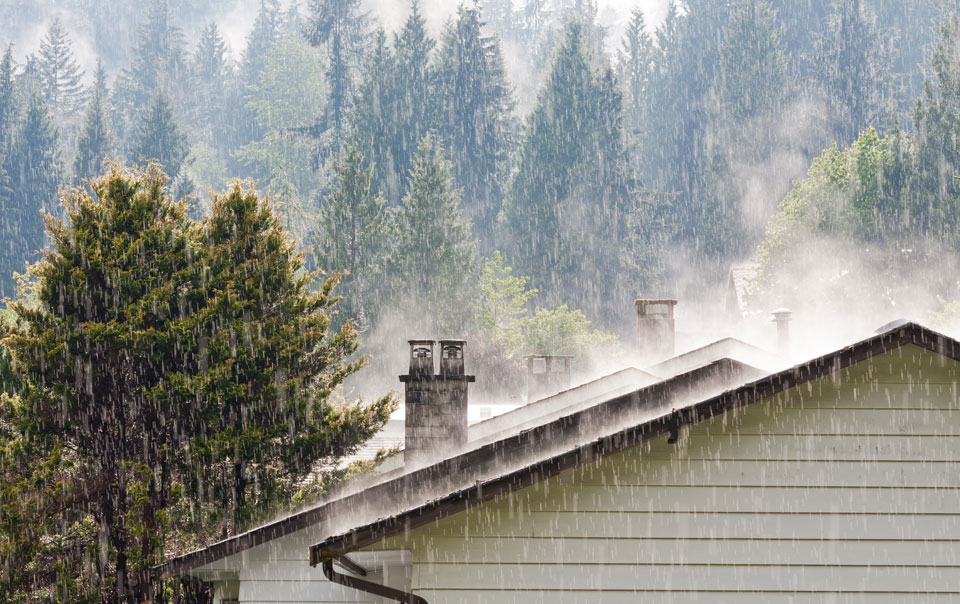Protecting Your Home from Stormwater Damage


A heavy rainstorm has finally stopped. Or maybe a long winter has finally ended, and the deep snows have begun to melt.
While good weather may seem like a relief, the potential for water damage may just be beginning. Stormwater runoff can quickly overwhelm natural and manmade systems, leading to flooding and property damage.
The steps you take today to prepare your home and yard for proper drainage can help avoid time-consuming and costly repairs when the bad weather does blow through.
In a natural environment, stormwater runoff is absorbed by soil, evaporates into the atmosphere or flows into bodies of water, such as streams, lakes or rivers. Homeowners may need to re-create the natural environment on their property to address stormwater runoff. This includes planting trees and other vegetation, building rain gardens and installing rain barrels or cisterns to collect roof water.
How can you protect your home from stormwater?
“The key to developing a yard drainage plan is to understand the specific characteristics of your property and implement the system that works best for you,” says Mike Koppang, a Travelers Risk Control professional. During a storm, you can go outside and observe how the water flows. Take note of the different grades and slopes and whether they divert the flowing water away from your home. Look for any low spots that collect or pool water and for any steep slopes that have indications of surface erosion.
Consider the steps needed to protect your property from water runoff. Rain that falls on roofs, driveways, patios, roads and other impervious areas moves across the ground surface at greater speeds. The property adjacent to these areas could be more susceptible to damage. Frozen soil can also increase risk of damage by preventing water from being absorbed by the soil. Replacing impervious areas with pervious surfaces, such as permeable paving stones or pavers, can also help.
Other questions you might consider:
Is stormwater that falls on impervious surfaces diverted away from your house? This is the work of things like roof gutter downspouts, driveways, walkways and patios. Runoff from these surfaces should be directed to an area that has the ability to absorb or slow the surface flow, such as landscaped areas, and away from your house.
Does your house have a stream, pond or lake close by? Consider the flood potential and how it may impact your property. You can research local flood maps that will detail floodwater levels for various storm events and their flood potential.
Does your driveway or other impervious surface have a negative pitch back toward the house? Consider installing trench drains or area drains to help prevent pooling and divert water away from the house.
Do you have retaining walls on your property? If so, it is important that the walls have a drainage system in place to alleviate pressure behind the wall. Periodically clean weep holes to ensure they are not clogged. Surface water should not be allowed to cascade over the top of the wall and instead should be diverted to the end of the wall or around it.
Is a portion of your house below ground level, such as a basement? Make sure any sewer and water lines, or any other pipes or lines that penetrate subsurface walls, and foundation cracks are properly sealed. Basements that are prone to water intrusion should have a water collection system in place, such as a sump pump system. This system should be maintained with a battery backup for continued operation in the event of a power failure. Consider elevating mechanical systems or installing curbs around areas that need protecting but cannot be elevated, such as finished areas and storage areas. Exterior basement window wells should have covers and the ground surface of the well should be below the well rim.
Do you have a sewer or septic system and property with known high water tables? Have the system checked by a professional. If the groundwater rises too high, it can affect the efficiency and operation of the system. In some cases, this may lead to sewer backup or waste leaching above the ground or back into the house.
Surface stormwater is not the only consideration for protecting your home. It is also important to assess the functionality of your whole home envelope system. Make sure that your house exterior is maintained, including roofing, flashings, weather barriers, windows, doors and sealants.
While you cannot prevent against all damage from stormwater runoff during large acts of nature, these steps can help protect your home when storms do hit.



